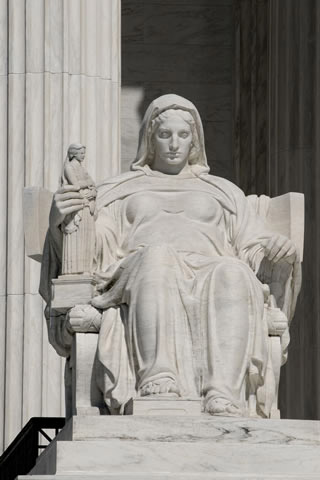On Monday, May 4th, Draw Up Your Chairs: The Supreme Court Televised On C-Span For the First Time

Contemplation of Justice, right*, James Earle Fraser sculptor, 1935
"C-SPAN is committing to airing live each of the Supreme Court's just-announced schedule of oral arguments for May, which will be held by teleconference. The audio of the arguments will be accessible live via one of the C-SPAN TV networks, online via C-SPAN.org, and on the free C-SPAN Radio app, which will allow them to be heard via anyone's cell phone. Photo and name IDs of the justices and counsel will accompany the audio feed on television; name IDs will be provided on radio.
The Court will hear oral arguments by telephone conference on May 4, 5, 6, 11, 12 and 13 in a limited number of previously postponed cases. In keeping with public health guidance in response to COVID-19, the Justices and counsel will all participate remotely. Below is additional information concerning the order of business on the morning of argument.
The Court will use a teleconferencing system that will call counsel the morning of argument. All counsel for the cases to be argued that day will be called simultaneously at approximately 9:15 a.m. and will all be placed on a conference call with the Clerk of the Court, Scott Harris, to receive any last-minute instructions and to ask any remaining questions they may have. Once that briefing is completed, the phone lines for counsel will be muted, and counsel will remain on this same line until approximately 9:50 a.m. At that time, counsel will all be moved to the main conference call to await the beginning of argument.
At 10 a.m.[Eastern], the Justices will enter the main conference call, and the Marshal of the Court, Pamela Talkin, will cry the Court. The Chief Justice will call the first case, and he will acknowledge the first counsel to argue. Following the usual practice, the Court generally will not question lead counsel for petitioners and respondents during the first two minutes of argument. Where argument is divided and counsel represents an amicus or an additional party, the Court generally will not ask questions for one minute. At the end of this time, the Chief Justice will have the opportunity to ask questions. When his initial questioning is complete, the Associate Justices will then have the opportunity to ask questions in turn in order of seniority. If there is time remaining once all Justices have had the opportunity to question counsel, there may be additional questioning.
Once the time for the first counsel’s argument has expired, the Chief Justice will thank counsel for their argument, and acknowledge the next attorney. This process will continue until argument in the case is complete. Counsel for the petitioner in each case will be allotted three minutes for rebuttal. If there is a second case to be argued that day, the Chief Justice will call that case promptly after the end of the first argument, and the same process will be followed. The Marshal will announce the conclusion of arguments.
*Contemplation of Justice: The United States Supreme Court Building Commission selected James Earle Fraser to sculpt two statues beside the steps of the entrance to the Supreme Court Building. Fraser completed preliminary models in 1933 and over the next year, he continued to hone his work. The sculptures were installed in 1935, a month after the building opened. Fraser described the female figure, Contemplation of Justice, to the left of the main steps as "a realistic conception of what I consider a heroic type of person with a head and body expressive of the beauty and intelligence of justice." A book of laws supports her left arm and a figure of blindfolded Justice is in her right hand.
Editor's Note: For those of you with children and grandchildren interested in science and the future, do not forget NASA station, NASA.gov!






